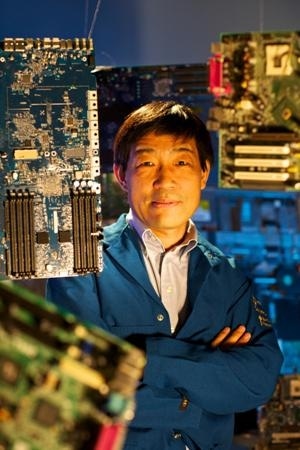Mar 3 2016
A team of researchers, led by a group at the University of California, Riverside, have demonstrated for the first time the transmission of electrical signals through insulators in a sandwich-like structure, a development that could help create more energy efficient electronic devices.
 Jing Shi, a professor of physics. Credit:L. Duka
Jing Shi, a professor of physics. Credit:L. Duka
Conventional electronic devices rely on the transport of electrons in a semiconductor such as silicon. Now, researchers are exploiting the 'spin' of the electron rather than its charge to create a new generation of 'spintronic' devices that are potentially more energy efficient and more versatile than those currently making up silicon chips and circuit elements.
The UC Riverside-led research, which was published online Wednesday (March 2) in the journal Nature Communications, is significant because it demonstrates that a tri-layer, sandwich-like, structure can serves as a scalable pure spin current device, an essential ingredient in spintronics.
A key element in this breakthrough is the material. To demonstrate the effect, the magnetic insulator needs to be truly insulating, or there will be a parasitic signal from leakage. On the other hand, a high-quality magnetic insulator grown on metal had never been demonstrated.
Using combination of sputtering (for metals) and pulsed laser deposition (for insulator), we successfully showed that the 50-100 nanometer thick magnetic insulator, such as yttrium iron garnet, is not only magnetic and insulating, but also of high quality when it is grown on 5 nanometer thick platinum.
In the structures used by the researchers, there are two metals and a magnetic insulator in between. The metals are for spin current generation and detection (conversion of spin current back to charge current) via the so-called spin Hall effect and inverse spin Hall effect.
The magnetic insulator is an electrical insulator but a good spin current conductor. The spin current flowing in the insulator does not involve mobile electrons therefore it does not dissipate energy as an electrical current does in joule heating.
The researchers have also demonstrated that the signal transmission can be switched on and off and modulated in its strength by a magnetic field. The electrical signal transmission through the magnetic insulators can be switched on and off depending on the magnetic state, or direction of the magnetization, of the magnetic insulators.
So the direction of the magnetization can be regarded as a memory state of non-volatile random access memory devices. In addition, the signal level can be modulated by changing the direction of the magnetization; therefore, it can also be used as analog devices. The sandwich structure can be made small by nanofabrication so that the devices can be scaled down.